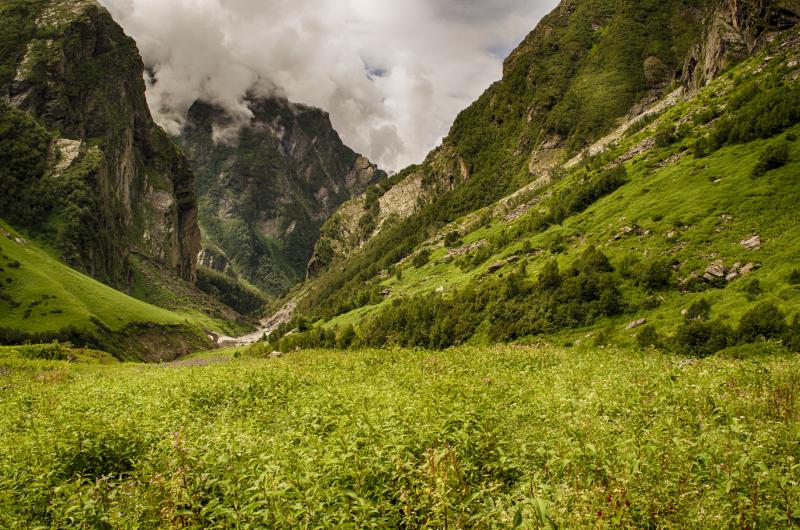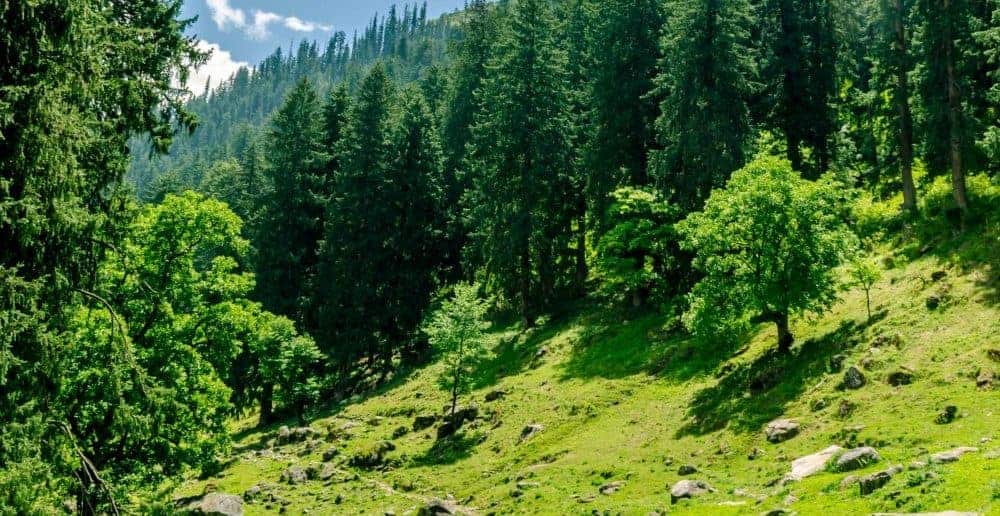Malari village is situated in the extremely isolated corners of the Dhauli Ganga valley. This tiny village lies in the Nanda Devi Biosphere reserve near the Tibet border. A World Heritage site, this area is located 61 km from Joshimath, in Chamoli District of Uttarakhand.
Almost everyone has heard of the Valley of Flowers (and rightfully so), but no one is aware of the Valley of Perfumes located near to this village! The Valley of Perfumes is home to hundreds of species of flowers, all adding up to make for the most magnificent of aromas. The valley can be reached using two-wheelers and while your sense of sight has been gifted enough during this trip, your sense of smell will be delighted too! Must visit.

Let's quickly dive into the details:
About Malari Village
Malari village is inhabited by the Indo-Mongolian tribes known as Bhotia – Scheduled Tribes of Uttarakhand. The Tolchas are the people living around Malari and the Marchhar live in the upper areas.
Given the extreme isolation of the village and the heavy snowfall it experiences – the village is inaccessible during the winter seasons. In fact, the inhabitants of the village also move down for the winter season.
While the village may seem quaint – given that homes are few and simple – but the villagers are well-to-do. They cultivate herbs that have medicinal properties and are often high in demand with pharmaceuticals.
Location
With an elevation of 3048 meters, Malari village is surrounded by sharp snow-covered mountains. Located in the Dhauli Ganga Valley of the Nanda Devi Bio Reserve or Chamoli district, Uttarakhand – Malari is unheard of and better yet – unexplored! You’ll be mesmerized by the beauty of the mountains along with the quaint Himalayan homes with their unique architecture in the slate roofing of old houses.

Weather
The winters are extremely cold. So much so, even the villagers move to lower elevations only to move back during the summer months. Summers are synonymous with what most of the Himalayas experience – mild, calm, pleasant. In short, it is the perfect weather to explore.
The place is best avoided in the monsoon season as the routes are terrible and prone to landslides! Temperature-wise, expect a maximum of 12 degrees in the summer and a minimum of 4 degrees celsius.
Best time to visit Malari
Although most online resources (of which there are scanty!) will tell you to visit Malari during April – June, and August – September. However, if you have conversations with the locals and the army officers- you’ll be strongly suggested to make your travels just after the monsoon – i.e. around August end. The vegetation gets thicker and the mountains are just purely luscious! It is an especially scenic time in the valley, then!
How to reach Malari village
In order to reach Malari Village, you’ll need to reach Joshimath first. From Joshimath, the distance to Malari is 60 KMs, and is especially very scenic and gradually developing. The route will show you the familiar lush green Himalayan peaks to blatantly different rock formations. If you’re lucky, you’ll be able to spot plenty of Himalayan wildlife enroute – including Himalayan Thars, Musk deers, mountain goats, and even snow leopards.
By air
If you’re planning on covering part of the route by air, then the nearest airport is Jolly Grant Airport, Dehradun, located 332 km from the village. The airport enjoys comfortable connectivity with major Indian airports.
By rail
Another option for part of the route is by rail. The nearest railheads to Malari village are Dehradun, 354 KMs, or Rishikesh, 316 KMs. You’ll be able to access taxis – both shared and private – to reach Joshimath. From there, you’ll have to change gears and hire a new taxi to get to Malari.
By road
The route to Joshimath can be covered from Rishikesh. However, during certain times – you should be prepared to experience some traffic.

Things to do in Malari Village
Given the extreme isolation of the region – you shouldn’t expect much tourism. The villagers are super helpful and accommodating and are always up for a conversation! I would suggest you indulge in the experience and enjoy the slower pace of life. Of course, given the charm of lesser-known villages, in the remotest parts of the state, there’s a lot of wild to explore
Hiking
There are multiple hiking routes near the village. The Nanda Devi Peak Trek’s base camp is situated just 20 KMs from here – Lata Village. Another cool trek from here is to Dronagiri, which is believed to be the place where Hanuman brought the Sanjivani to cure Laxman in Ramayana.
The Malari-Munsyari trek
The Malari-Munsyari trek has a captivating true foundation. Historically, prior to the arrival of contemporary transportation structures, the tribals of Malari, as well as Milam, utilized this course for their social and monetary collaborations. A few symbiotic relations were likewise settled through this course.
Geologists and understudies of geology will especially cherish this trek, for it goes through a place called Lapthal where fossils of old marine life can be viewed as unquestionable verification to the way that a few million years back the Deccan Asian plate remained separated from the Asian structural plate with a sea in the middle.
Step by step the Deccan plate moved northwards and slammed into the Asian plate shaping the Asian mainland and the forceful Himalayas out of the spill of sea rubble from what used to be the floor of the Tethys Sea.

Niti Village
About 18 km from Malari, Niti is the last village in India, bordering Tibet. At a height of 3600 mtrs, Niti is situated near the southern Tibetan border. The Niti Pass located at 5800 mtrs connects India with Tibet. There was a day and age where the Niti Pass connected India and Tibet on the trade route.
The villagers of Niti still follow the traditional methods of lifestyle in the mountains. Niti Valley is one of the last repositories of the unique trans Himalayan culture and customs which are still practiced with devotion by the Bhotia community. The Lapsu, Mask Dance, Sitoon, and celebrating Sangrand (first day of the month on moon calendar) are some of the unique customs still prevalent among the Bhotia community.
Now, special permission has to be taken from the administration to go beyond Malari. The village has its own beauty in terms of nature and the residence pattern of people residing in the village. Malari is the Summer migration place for the villagers. The people of the village a 6-month migration pattern. They only live in the village during a period of 6 to 7 months i.e., from mid-April to mid-September or the start of October. then they again migrate to another place for winter migration.

Best places to stay in Malari
Finding lodging in Malari might prove to be a task as Malari is one of the remotest villages located on the Indo-Tibetan border. There are few budget guesthouses at Malari. Trekkers traveling to Malari should carry camping equipment with them as they would have to camp out in the open due to the unavailability of guesthouses.
Best places to eat in Malari
Apart from few tea stalls serving snacks, there are no restaurants or eating joints at Malari. One has to keep in mind Malari is more of a migration village and remains under thick snow in winters. In addition to that, one can try authentic Garhwali cuisine if one is able to find a roadside dhaba serving the Pahari dishes. Also, if you can – you must try the local glasses of Kacchi – a fermented drink enjoyed by the locals.
Tips and tricks
- You will need an Inner Line Permit to visit Malari (and subsequent villages). Permission from SDM, Joshimath is required.
- Carry Ready-to-Eat and Snacks with you as if you’re heading out into the woods- food would be a problem.
- There is an STD PCO available in Malari. Accommodation, though scarce, is not unavailable. If you’re polite and courteous – villagers are very reliable to help out.
- Wear layers and always keep yourself warm
Conclusion
When you visit offbeat places like Malari village, you realize that yes, the destinations can totally be worth the journeys too! Malari adds in a lot of charm, quietness, quaintness, and a special something that is so unique about Himalayan towns and hamlets!
Have a travel question?? You can subscribe to my YouTube channel and leave a comment to ask your travel questions about traveling to the Himalayas.
Yes, the journey is tough and grinding and the location is extremely isolated. But, also, you will be rewarded in multiples with so much to ponder about and explore. A must-visits for the true wander lusters, wanting to be in touch with nature!


![Traveling to Malari Village – An offbeat place Uttarakhand [Travel Guide] Alaknanda River, curving its way through the Himalayas](https://discoverwithdheeraj.com/wp-content/uploads/2017/09/DSC_0041-1536x1028.jpg)



